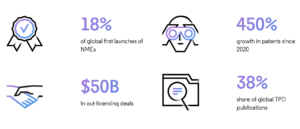
‘Adrenaline’ of the immune system discovered
Portuguese and Swiss scientists have discovered that neurons located at mucosal tissues can immediately detect an infection in the organism, promptly producing a substance that acts as an "adrenaline rush" for immune cells.
Under the effect of this signal, immune cells rapidly become poised to fight the infection and repair the damage caused to surrounding tissues, the researchers from Champalimaud Centre for the Unknown and Instituto de Medicina Molecular (both in Lisbon) and from the EFPL (Lausanne) report in Nature.
Most neurons in the body are located in the brain and its vicinity – the central nervous system -, with neurons projecting their axons to every tissue in the organism by way of the spinal cord. Nevertheless, throughout the body there is a very abundant number of peripheral nervous cells. These are so numerous in the gut that they have collectively been dubbed "the second brain".
In a previous study, senior author Henrique Veiga-Fernandes and colleagues demonstrated that a type of glial cells in the gut, they dubbed innate lymphoid cells 3 (ILC3), can trigger cells of the innate immune system to produce antibacterial compounds. In the current study, they turned to ILC 2 cells, which are located at the body’s barriers – the gut, the skin, and the lungs – to produce immune responses against foreign invaders.
The study brings "two big novelties", says Veiga-Fernandes. The first, he explains, "is that neurons define the immune cells’ function. Nobody could have imagined that the nervous system coordinates, commands and controls the immune response throughout the whole organism." Second, he adds, "it’s one of the fastest and most powerful immune reactions we have ever seen". Comparatively, the newly discovered neuronal stimulus induces an immune response in a few minutes, while the immune response following vaccination typically takes several weeks to mount.
"In high-resolution microphotographs of the lungs and gut of mice we saw that ILC2s were placed along the axons of neurons residing in these mucosa, a bit like pearls on a string", explains Veiga-Fernandes. "So we asked ourselves if these two distinct tissues could productively ‘talk’ to each other."
To test this hypothesis, the team started by analysing the whole genome of a series of immune cells – ILC1s, ILC2s, ILC3s, T-cells, etc. -, "searching for genes that code molecules that may act as receivers of neuronal signals", said Veiga-Fernandes. They found that only ILC2s possessed a receptor protein (NMUR1) for a neuronal messenger called neuromedin U (NMU). Since neurons are the only cells that produce abundant levels of NMU, this indicated that only neurons could be sending this signal to ILC2s.
Later, they used a rodent parasite, Nippostrongylus brasiliensis (a sort of hookworm) to infect control mice and mutant mice whose ILC2s didn’t express NMU receptors. In the first group of animals, the innate immune cells immediately triggered a response to neutralise the parasite and repair damaged tissue. In the second group, the mice were unable to fight the infection and the damage caused by the parasite.
The researchers also showed that neurons are able to detect the products secreted by parasites that infect the organism – and that, when this happens, they rapidly produce NMU. In turn, NMU acts vigorously on ILC2s, thus generating a protective response in a few minutes.
Currently, the findings impact on humans are open. However, the analogs to ILC2s in humans also carry NMU receptors at their surface. Veiga-Fernandes has filed a patent application.
Veiga-Fernandes results are complemented by results of an international team headed by David Artis
from Cornell University and Donna L. Farber from Columbia University (both in NYC, US). Independently from Veiga-Fernandes and co-workers, they report in the same issue of Nature (doi:10.1038/nature23676) that ILC2s in the mouse gastrointestinal tract co-localize with cholinergic neurons that express the neuropeptide neuromedin U (NMU) and that ILC2s selectively express the NMU receptor 1 (NMUR1). Additionally, they demonstrated that vitro stimulation of ILC2s with NMU induced rapid cell activation, proliferation, and secretion of the type 2 cytokines IL-5, IL-9 and IL-13 that was dependent on cell-intrinsic expression of NMUR1 and G?q protein. In vivo administration of NMU triggered potent type 2 cytokine responses characterised by ILC2 activation, proliferation and eosinophil recruitment that was associated with accelerated expulsion of the gastrointestinal nematode Nippostrongylus brasiliensis or induction of lung inflammation.
Conversely, worm burden was higher in Nmur1?/? mice than in control mice. Furthermore, use of gene- deficient mice and adoptive cell transfer experiments revealed that ILC2s were necessary and sufficient to mount NMU-elicited type 2 cytokine responses. The US-led group concludes that "the NMU-NMUR1 neuronal signalling circuit provides a selective mechanism through which the enteric nervous system and innate immune system integrate to promote rapid type 2 cytokine responses that can induce anti-microbial, inflammatory and tissue-protective type 2 responses at mucosal sites.


 White House
White House Clarivate
Clarivate H. Zell - wikipedia.org
H. Zell - wikipedia.org